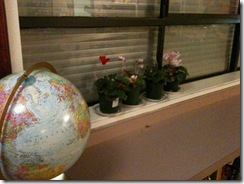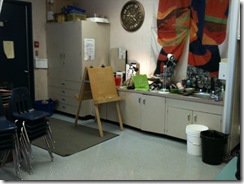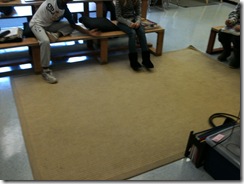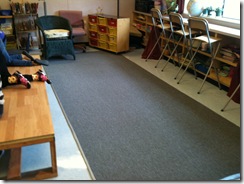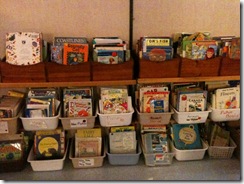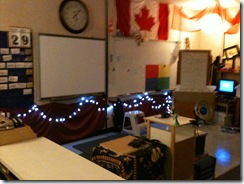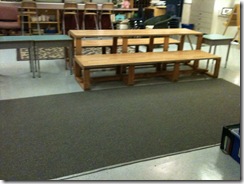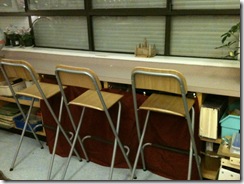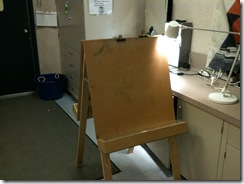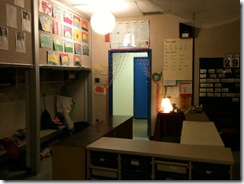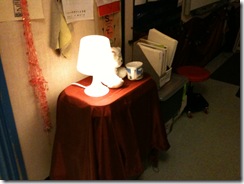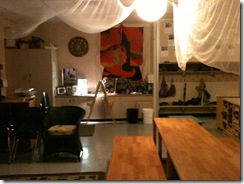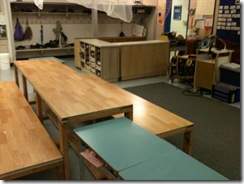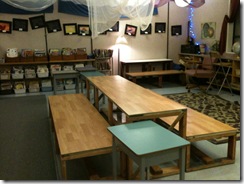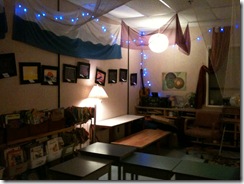A blog describing my crooked pathway toward educational enlightenment through classroom design. Overview of this site in Prezi: http://prezi.com/aojirtdlkazv/classroom-design/ Twitter: @gooomanji
Thursday, April 26, 2012
Liquid Networks
Even though the group was diverse, there seemed to be a strong thread of like-mindedness. There was one to one mingling, small group conversations, and full group discussions. Maybe it was the full group discussions after the sharing that made me see how connected the group was.
I've said previously that you can't focus group for innovation. That might not be true anymore for me. If you bring together the right group, it is possible. With the group last week, the messages I took away were: anything is possible, and the same old model of education just doesn't cut it anymore.
Tuesday, April 24, 2012
Steal Like an Artist
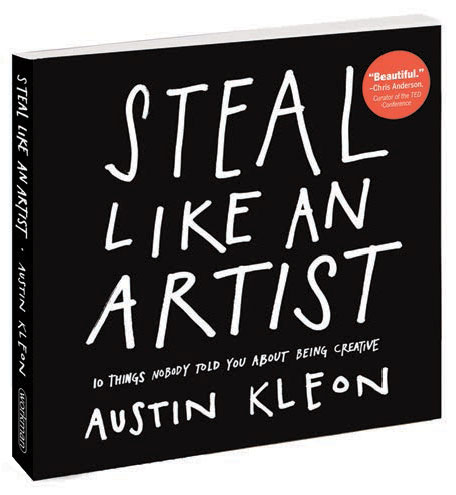 |
| from http://www.austinkleon.com/wp-content/uploads/2011/09/steal-cover-3d.jpg |
There are some really practical bits of advice that drive creativity like:
"Use Your Hands."
So much of what I do is thinking and writing on my computer. Yet my most creative times are when I get dirty and build or create something. And apart from being with my family and friends, they are my happiest times too. Kleon has inspired me to doodle more and write things in notebooks. I am looking for my fountain pen because I love the feel of the nib as it skates across the surface of the paper. I like the randomness of creating webs when I brainstorm instead of the precisely aligned organizers I create with my computer. I've gained some efficiency by using my iPod apps, but I've lost something in my creativity by not using physical objects. And maybe it's why I've enjoyed the design process so much. It takes thinking and reflecting, but I am creating something tangible too.
"Side Projects and Hobbies Are Important."
I think I mentioned that I play in a jam band with some other staff members every Thursday. When I came to the staff, I thought it was odd that there were all these musical people who didn't play together. When we started playing together it was rough sounding, but fun. We've grown as a band over the years, but more importantly, we've grown as a team. A lot of the skills and attitudes we've learned as a band have carried over into our teaching: we've learned to listen to each other to bring out the best in the group; we each take the lead as the song or circumstance dictates; we've learned to persevere and laugh while doing so; and we've learned to trust each other as we take risks and go outside our comfort level (this is the same band that does "Comfortably Numb" and "I Never Promised You a Rose Garden").
"Don't Wait Until You Know Who You Are to Get Started."
You can't predict which way your art, your teaching, or your life is going to go. You can front load all you want, but until you are in the thick of it, you have still may not have any clear direction. It is the process of working with and through these situations that form who you are, and who you are will determine how you teach and how your life is going to go. With my design journey, I had a rough plan: have as much fun as possible until someone tells you to stop. The thing is, I'm still having fun, and no one has really told me to stop. The journey has been great! It has affected my teaching and the students' learning, and I've learned things about myself that I didn't know. It's as if I decided to use emergent curriculum on myself before I sprang it on my kids. It's only fair.
"The Secret: Do Good Work and Share It with People."
This bit really spoke to me. I think it's why I started this blog. I wanted to share with other my design journey and see what the world thought. As it turns out, the educational world seems to be heading in the same direction I am going. It also turns out that it wouldn't really matter if no one read this blog (though I do appreciate my 7 faithful readers which will hopefully include my mom one day) because I found out that I process information best by writing. It is the act of writing that seems to shake some things loose and consolidate others. The evidence is that when I am with a big group of people (say, more than 2), I don't say too much. But when I get home and I email the same two people about a thought I had and I go on for about 13 pages. I am WAY more articulate as a writer than I am as an orator. So in this case the act of sharing for me is a purely selfish one.
I don't think of myself as an artist, but I definitely see the benefits of thinking like one when I am trying to tap into my creativity. Thanks Austin!
Wednesday, April 18, 2012
Are Parents Lining Up to Have Their Kids in My Class?
Someone from the district came by to have a look at my odd-looking classroom. She liked it and understood the intention and the spirit of it. She was taking a few pictures, and she turned to me and asked, “Are parents lining up to have their kids in your class?” I was a little surprised as I never thought of my project as a “magnet” program. Also, the question never occurred to me because the answer is, “No.”
On reflection, there are good reasons why this is so.
The first reason is: There are a whole bunch of really incredibly talented teachers in my school. We have a huge shared set of beliefs, but we have individual talents and idiosyncrasies that make us stronger as individuals and as a team. My design project is just another one of those idiosyncrasies. Other teachers on staff are far ahead me in terms of things like the ethic of care, social responsibility, play and project based learning, technology, and just awesome teaching. You could walk into any classroom in my school and see something great going on. It’s a pretty exciting and fulfilling place to be. So my adventure in design just happens to be another education-forward concept being played out in my school.
The second reason is: Parents and kids don’t really get it. Well, not the parents and kids outside of my classroom. The kids I teach really get it. Our classroom is a calm and cool place to be. The space is flexible in that we can turn it into any kind of space we need it to be. There are zones within the classroom that accommodate different kinds of learning and different kinds of learners. Our room works for us, we don’t have to work in spite of the room. The parents of my students are just happy that their children like coming to school.
Now about the kids who I don’t teach, a lot of them do not understand what we are trying to achieve in my room. Their needs might be different, but also their idea of school may not have changed because they haven’t experienced anything outside of the traditional model. And when students are given choice, it is interesting to see what they want. One of my friends let her students pick how they were going to organize the room. This is what they came up with: Rows!
This teacher almost cried. She has been working all year to change the atmosphere of her class. First she had tables. Then she set up interesting zones for learning with couches, carpeted areas, a combination of desks and tables, etc. And then she opened up the discussion with her grade 1s and 2s. She documented the discussion (and her resistance to the idea on this letter posted in her classroom).
Though this may seem it goes against what we are trying to achieve with classroom design, it really doesn’t. What this teacher and I are trying to do is make the space the best possible environment for learning for our students in our context. The challenge comes when that vision differs among the teacher, students, and the parents.
Wednesday, April 11, 2012
The Pride of Ownership
It's the reason I have gone as far with this design journey as I have. It is MY project. No one told me to do it and no one told me I HAD to do it. It started by accident, I started having fun with it, and it took on a life of its own. Even though my journey has been due to a bunch of happy accidents, I still feel like I am in control because I still make the decisions including whether or not to continue.

I myself have come to agree with this rationale, with and without the inclusion of a little hexagonal wrench. I love all the things I built myself despite their wobbly, ugly, or illogical composition. The emotional investment I have in each piece is irrational but undeniable. My favorite creation, my daughter, I have become quite attached to. It makes no sense. She is a liability in terms of capital in flow. She takes up huge amounts of time, space, and energy. At the beginning, when we brought her home, she wasn't terribly useful, yet I love her more than any other thing I've created or any other investment I've made. Go figure.
But the irrationality of my feelings makes sense. It is the pride of ownership, not that I own my daughter, but it is the sense of marveling at something I've had a part in creating or helping to develop. Look at the experiment I talked about in my last post. My students love their classroom because they had a hand in forming it. They have an investment in making sure that it fits their own and everyone else's needs.
Friday, April 06, 2012
Audience Participation
Here are some Before shots:
They set to, and I was impressed with how harmonious the moves went. They didn't seem to have an overall plan, but they definitely went to the places that they wanted to change the most. The big targets, which also happen to be the biggest pieces of furniture, were the risers and the rolling storage bins. Small teams of students clustered around them and then decided where they were going.
Another partnership rolled up the gold carpet (the third picture above). I bought the huge, almost new carpet at a garage same for $5! I thought it was such a great deal … until we sat on it with dark pants. The shedding fibres made it look like we’d been mauled by a Golden Lab with dermatological issues. But until recently, we kept the carpet because it added to the warmth of our classroom. They replaced the carpet with the very utilitarian grey carpet remnant. We filled in the blank spot at the back where the grey carpet had been with the unraveling indoor/outdoor carpet we’d had in our class a long time ago. (I’d moved it into the the teacher oasis I created a while back. Incidentally, I moved the gold carpet into the teacher space, as we don’t roll around on the floor too much).
The students dismantled the horseshoe that the risers formed. I was disappointed because it really added to the communal feeling we had, especially during instructional times. Though they dismantled the riser horseshoe, they created another smaller horseshoe with the rolling storage bins.
The After and the Reasoning
I was a little dumbfounded about their choices and moves, so we debriefed afterward. I was blown away! Weeks ago, I showed them the set up of the Apple Store, and they really liked the zones created by furniture there. The zones were flexible, but each emphasized different kinds of activities and interaction. They had set up our class in the same manner! The carpet at the front is intended for instruction because it allows all of us to see the Smartboard as I am giving instructions.
Here is the Campfire area they created:
At the Apple Store, they liked a private space where people could turn their backs or be shielded from distractions for concentration and privacy. With the rolling bins, they created a cave of silence. Students can go inside the the horseshoe or they can stand and work at one of the rolling bin carts. There are additional silent, private spots at the back window counter and the easel.
Here are the Caves the students created:
The rest of the riser and carpet spots were set up for individual, partner, or small group work. They moved the risers so that people could talk or work, but they dismantled the horseshoe so that the small groups did not interfere with each other. They recognized that when all of the talking groups were together in one tight spot, it got too loud. With the risers being separated, now they had three different zones for interaction, instead of just one. Notice that they kept the picnic bench set up of the long risers so they could sit on either side and talk across it.
Here are some Watering Holes the students created:
I don’t ever remember telling my students about the Campfire, Watering Hole, and Cave concepts. Regardless, they see the need for such zones for themselves. Notice that they also kept some desks for people who want their own space. They also put them in front of our classroom library. Just like the Apple Store, we try to keep the unsightly rows of items that are stored on shelves blocked from view. In this case, the desks block the books. At the back counter where there are other shelves with things stored on them, I tried suspending a taffeta curtain. It gets pulled down by people’s feet, so I am looking for a better solution.
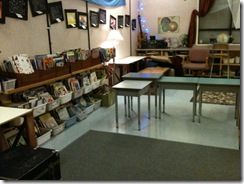
There is definite pride of ownership. Right after reorganizing the classroom, we had a school-wide writing activity where students were allowed to go anywhere in the school to write. None of my students left our classroom. Though there are still some problems with our classroom, (I miss our horseshow for discussions where everyone can see everyone else), the benefits outweigh the drawbacks. The students are proud of their classroom, they use the spots appropriately because they designed them for their own purposes, and the classroom seems bigger. I was trying to figure out on my own how I was going to create Caves in our classroom for the last few months. In the same time it takes for my students to clean the classroom at the end of the day, my little designers fixed a lot of the problems I was working on.
A useful 12 minutes.
Tuesday, April 03, 2012
Who is in the driver's seat?
Young people just have different priorities, and it is the divide in priorities that creates the alienation. Older people point out that even though kids value video games, they will go online to cheat to get to the next level. The thing is kids don't see this kind of "cheating" as amoral; in fact, they are appealing to a community of users to help them out so that they can get on with things and maximize their enjoyment of the game. In their own minds, the youngsters are still solving the problem because they are using a solution strategy they think is the most effective at the time: asking for help. And it is the act of asking that puts them in the driver's seat.


